#Chapelle Saint-Aubert
Text
DD Season 2 Places Where Filming Occurred: Update to November 2023 post.
I originally did a post in early November of 2023 with filming spoilers up to that point. Link. Some of my speculations have already been confirmed. Here are some additional tidbits I collected. I did not have the time to research these in much depth. I would love it if someone does!

Chapel Saint Aubert in Mont St. Michael
A chapel may be a good spot for a resurrection.
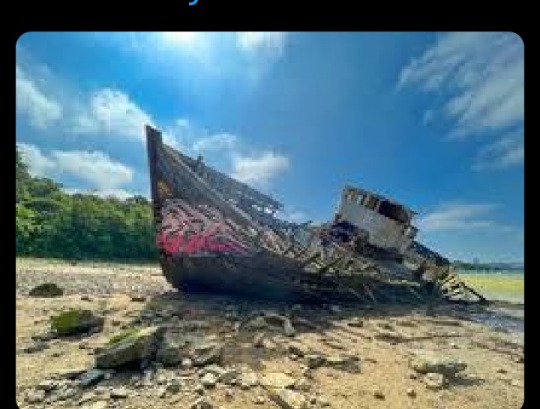
Shipwrecked boat on St. Malo Beach. Filmed summer 2023 and November 2023.
Hoverport Tunnel: I think this one is most important for TDers.
The tunnel was filmed in November and December. The actor who plays Losang posted about it here:

So, at first, I thought this might be the Carol/Daryl reunion spot, but it's awful late in the season for that. Carol, Daryl, and Cordon were seen filming at this tunnel location. It was under tight security and closed to the public. Here are some more shots of the tunnel and some behind the scenes pictures of what is in part of the tunnel.
The outside:

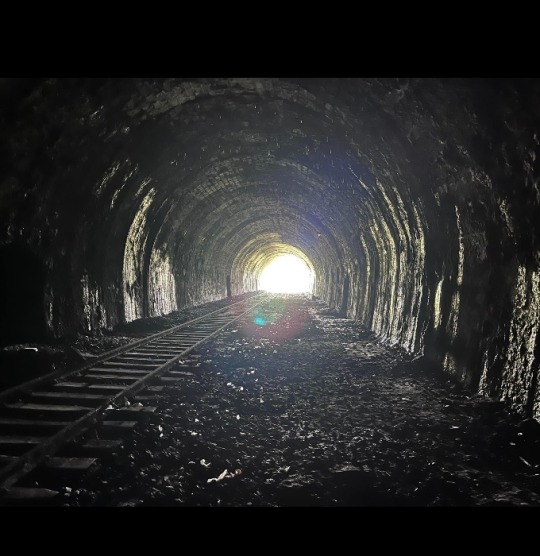
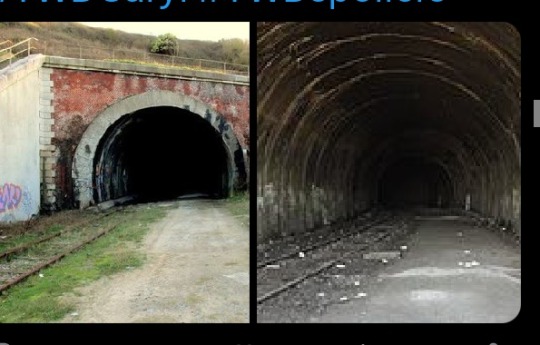

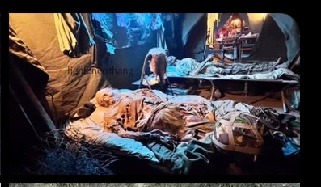
Some of the final scenes were filmed here and not on location:
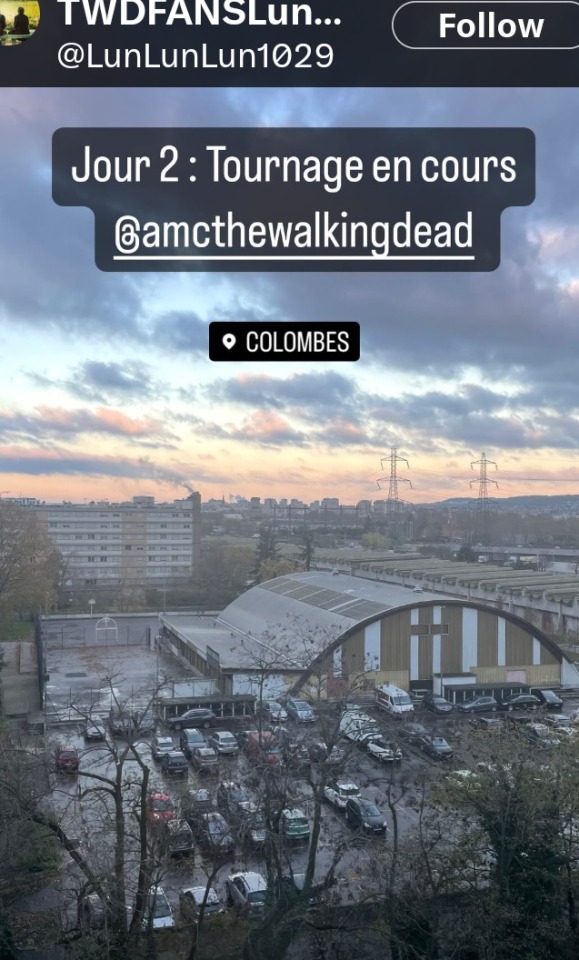
A few things about the tunnel. It is an old Hoverport Channel Tunnel connecting France to England. However, that doesn't mean that is how it will be used in DD. Also, just because the tunnel shoot was the last location, doesn't NECESSARILY mean that it will be where the season ends. I do think it will be very important, and it's something they tried to keep more under the radar than the rest of the location shoots. The tracks through the tunnel are obviously hugely symbolic in TWDU as places where characters choose a path that will lead to their salvation or their destruction. They also remind me of Daryl in Alone sitting next to the tracks and not choosing which way to go until the Claimers arrive. Even though Beth may not appear in the tunnel, I have a feeling it will an important location on the way to a Beth/Daryl and Beth/Carol reunion.
I know many people are saying this will be how season 2 ends:
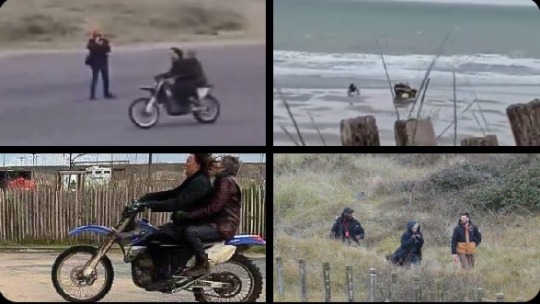
That might very well be the case, but filming continued at the tunnel location AFTER these scenes were filmed. As we know from TOWL, they often film MULTIPLE endings especially if there is an important reveal at the end.
Thoughts?
#team delusional#bethyl#team defiance#beth greene lives#twd daryl and beth#beth is alive#beth greene#beth is coming
22 notes
·
View notes
Text
Iconic Mont Saint-Michel Abbey celebrates 1,000 years
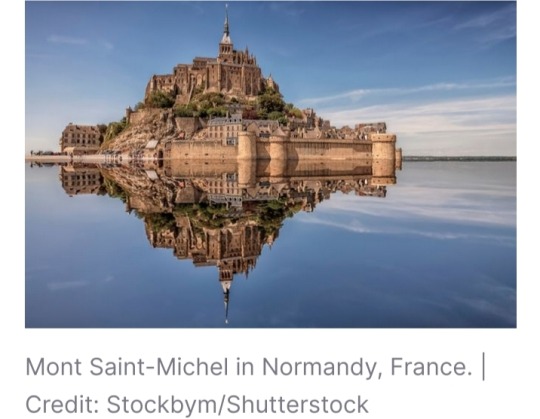
By Solène Tadié
13 June 2023
It was exactly a millennium ago that the first stone of the abbey church of Mont Saint-Michel in French Normandy was laid.
The monument that the poet Victor Hugo called the “Khéops of the West” has since become one of the highest symbols of French Catholic identity and one of the most important pilgrimage sites in the world, with more than 3 million visitors a year.
This important anniversary will give rise to a number of celebrations that will continue through the fall of 2023.
Standing on relatively inhospitable terrain, enthroned on a rocky islet less than a kilometer in diameter, surrounded by a vast sandy plain subject to the vagaries of the tides, the UNESCO World Heritage Site has stood the test of time, offering itself as a spectacle for dozens of generations to see.
Indeed, the history of this place of prayer and pilgrimage was as precarious and tumultuous as its surroundings.
While the construction of the present abbey church dates back to 1023, a first church dedicated to St. Michael the Archangel is said to have been built as early as 708 on the mount, then known as Mont-Tombe.
According to “Revelation,” the oldest text reporting the context of the abbey’s construction (written around the beginning of the 11th century), St. Aubert, then-bishop of Avranches, was visited three times in a dream by the archangel, who instructed him to erect a sanctuary in his honor on the summit of the site “so that he whose venerable commemoration was celebrated at Mont Gargan [the first great shrine dedicated to the Leader of the Celest Army, in the Puglia region of Italy] might be celebrated with no less fervor in the middle of the sea.”
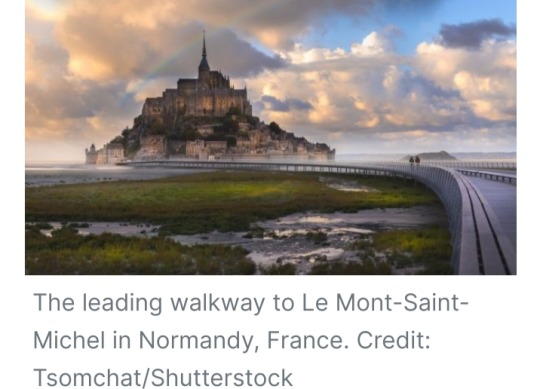
St. Aubert undertook the building of a first church with the capacity of about a hundred people, consecrated in October 709 and given the name Mont-Saint-Michel-au-péril-de-la-Mer.
The prelate installed 12 canons there, responsible for praying the Divine Office and welcoming local pilgrims.
The canons were replaced in the 10th century by Benedictine monks at the behest of Richard I, Duke of Normandy, who had little taste for the canons’ opulent lifestyle.
In 1023, the order undertook the construction of the abbey church we know today, based on three rock-cut crypts and the former chapel.
This ambitious project marked a decisive step in the international outreach of the site, where miracles abounded as the flow of pilgrims from all over Christendom expanded.
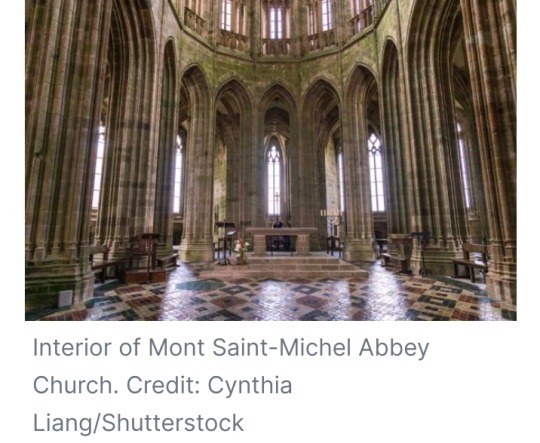
“This edifice is like Noah’s ark laid over the crypts,” said François Saint-James, a guide and lecturer at Mont Saint-Michel, in an interview with Le Devoir newspaper, underlining the architectural prowess required for this medieval project.
“It was a time when France was covered with a white cloak of churches, as a monk from Cluny once wrote. You have to imagine the gigantic scale of the work.
The granite blocks were cut on the Chausey islands, 34 kilometers from here.
Caen stone, a soft, light stone that’s easy to carve, was used. ... When, in the midst of the Hundred Years’ War, the Romanesque choir collapsed, it was rebuilt in flamboyant Gothic style.”
While the abbey’s architectural evolution continued uninterrupted until the 19th century, one of its highest points was the construction of “La Merveille” (The Wonder) in the 13th century, a jewel of Norman Gothic art.
It consists of two buildings on three levels, supported by high buttresses, with a cloister and refectory, 80 meters above sea level, beneath which were built an almshouse, a storeroom, and guest rooms.
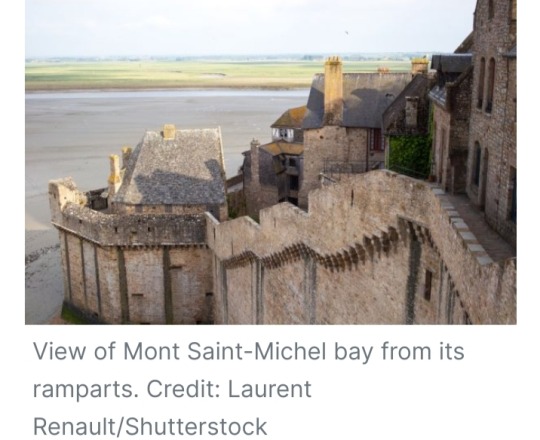
The fame of the shrine started to decline in the 17th century, when part of the abbey was turned into a prison by the royal power.
Seized by central government during the revolution, it became a detention center for priests deemed hostile to the Jacobin terror.
In the 19th century, the site, listed as a historic monument in 1874, was gradually returned to monastic life and its original vocation as a sanctuary.
The abbey’s distinctive silhouette was further enhanced by a neo-Gothic spire in 1897, topped by a gilded statue of the archangel.

To mark its 1,000th anniversary, a special tribute is being paid to the abbey that many have dubbed the “Wonder of the West” with the exhibition “La Demeure de l’Archange” (The Archangel’s Abode), retracing its glorious and tumultuous history through some 30 masterpieces, until November 5.
Many of these items, which include sculptures, scale models, statues, and silverware, will be on display to visitors to the abbey for the first time.
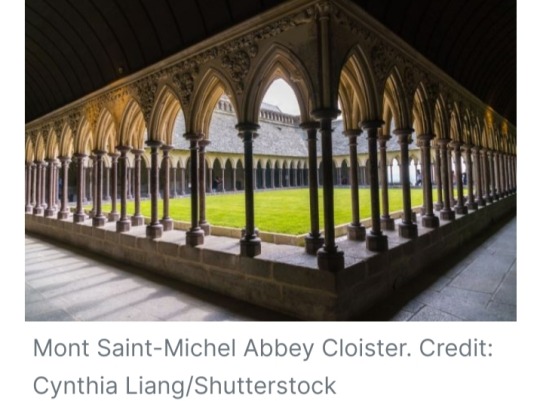
Another highlight of the many celebrations taking place over the summer and part of the autumn will be the “Millennium Solstice,” a never-before-seen light show projected onto Mont Saint-Michel from various spots in the bay on the evening of June 23.
The beauty of this sacred site, trodden by millions of pilgrims over the centuries, has been celebrated and immortalized in the writings of many great men of letters over the last few centuries, from Gustave Flaubert to Théophile Gautier and Victor Hugo.
In particular, it inspired the novel “Les Merveilles du Mont Saint-Michel” (1879) by the prolific writer Paul Féval.
He had already paid tribute to the monument a few years earlier, in “La Fée des grèves,” with these lines often quoted by admirers of the famous Mont:
“Twilight broke. Mont-Saint-Michel was the first to emerge from the shadows, offering the golden wings of its archangel to the reflections of the dawning dawn; then the sides of Normandy and Brittany lit up in turn.
Then again, a sort of light steam seemed to rise from the receding sea, and all was veiled except for the statue of Saint Michael, which dominated this wide ocean of mist.”
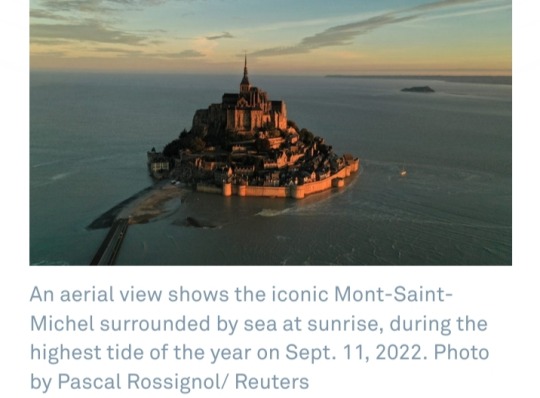
#Mont Saint-Michel#Khéops of the West#Victor Hugo#UNESCO World Heritage Site#pilgrimage#St. Aubert#Revelation#Mont-Saint-Michel-au-péril-de-la-Mer#Richard I#Duke of Normandy#La Demeure de l’Archange#The Archangel’s Abode#Millennium Solstice#Gustave Flaubert#Théophile Gautier#Paul Féval#Les Merveilles du Mont Saint-Michel#La Fée des grèves#St. Michael the Archangel
28 notes
·
View notes
Photo

Moonless Sky
Supernatural 1889 Paris | 18+ | No wc/app | Jcink Premium
site | guidebook & canons | discord
Hot plots are hot! Consider a new character with great connections and opportunities ready to go.
Montmartre Pack | Canons
Following their clash with a rogue pack, the well-meaning werewolves of Montmartre have picked up a new wolf and new enemies.
Étienne Aubert | Werewolf | 302
The dutiful leader and military man, struggling to exist as an individual and an alpha
The Saints | Canons
The St. Severin Security Agency presents itself as a premier provider of private guards and investigators for the affluent and politically connected. Behind the façade lies a network of skilled supernatural hunters
Reina St. Severin | Human | 45
The cutthroat mastermind and former criminal responsible for bringing the agency to Paris
Angélique Silvain | Gifted | 24
Magically skilled thief with a gambling debt to Christophe Gardien bought by Desmond (edited)
Gardien Family
Local heroes and criminals of La Chapelle | Just when the trail seemed to run cold, Clara reappeared as a werewolf with clues about their patriarch's murder.
Enzo _______ | Human | 30s
The adopted son - He may not be family by blood, but he'd do anything for the family that chose him, and he feels responsible for Clara's misfortune. What if his best isn't enough?
#jcink rp#jcink premium#advertisement#character request#supernatural#historical#1+ year#romantic#platonic#familial#professional
1 note
·
View note
Text
Succomber au charme du Mont Saint-Michel, cette Merveille de l'Occident
Succomber au charme du Mont Saint-Michel, cette Merveille de l'Occident
#MontSaintMichel
@OTMSMN
Imaginons pendant un moment que vous ne savez pas pourquoi il vous faut prendre la direction du Mont Saint-Michel. Ma mission sera donc de vous aider à trouver votre voie, n’est-ce pas? Si vous n’étiez pas convaincus jusqu’à l’heure, laissez-moi vous étayer mes arguments. La semaine dernière je vous expliquais comment venir au Mont Saint-Michel, il faut bien que cela serve !
Le but de cet article…

View On WordPress
#Abbaye du Mont Saint-Michel#Aller au Mont Saint-Michel#Archange Saint-Michel#Chapelle Saint-Aubert#Découvrir le Mont Saint-Michel#Evêque Saint-Aubert#Grande Rue Mont Saint-Michel#Histoire du Mont Saint-Michel#La Baie du Mont Saint-Michel#la Ruelle des Cocus#la Terrasse de l&039;Ouest#la Tour du Nord Mont Saint-Michel#Le Cloître Mont Saint-Michel#Maison du Pèlerin Mont Saint-Michel#Marée Mont Saint-Michel#Merveille Mont Saint-Michel#Mont Saint-Michel#Mont Saint-Michel Normandie#Mont Tombe#Parvis de la Croix de Jérusalem#Que voir au Mont Saint-Michel#Tour Gabriel Mont Saint-Michel#Venelle du Guet#Visiter le Mont Saint-Michel
3 notes
·
View notes
Text
Musée Rodin de Paris

L'Hôtel de Biron et ses jardins servent d'écrin à la plupart des œuvres d'Auguste Rodin, sculpteur de génie, précurseur de l'art moderne, au renom non terni par les ans ni par l'évolution artistique contemporaine, preuve en est de ses 700000 visiteurs annuels (en moyenne, moins les années covidées), le plaçant a la septième position des musées les plus visités de France.
Ce riche hôtel particulier, l'un des premiers à être édifié au sein du faubourg Saint-Germain (zone alors déserte et marécageuse, ne serait-ce la présence de l'Hôtel des Invalides tout proche), fut conçu en 1728 par l'architecte Jean Aubert, d'après des plans dûs à Jacques V Gabriel, pour le compte du "nouveau riche" Abraham Peyrenc de Moras. La décoration intérieure fut confiée au peintre François Lemoyne, (dont des "dessus-de-portes" furent restitués au cours du XXème siècle, après dilapidation le siècle précédent...) Suite à la mort du marquis propriétaire, survenue ici-même en 1731, l'hôtel échoit à sa veuve, qui le loue dès 1736 à la Duchesse du Maine, Louise-Bénédicte de Bourbon. Celle-ci y décède à son tour en 1753. Le futur acquéreur, Louis-Antoine de Gontau, duc de Biron, laissera son nom à l'hôtel. Il fit aménager les jardins dans le style anglo-chinois en 1781, via les cisailles du paysagiste Dominique-Madeleine Moisy. Après le décès du maréchal Biron en 1788, l'hôtel revient à son neveu, le duc de Charost, décédant lui-même en 1800. Sa veuve, après avoir loué l'hôtel au nonce du pape Pie VII puis à l'ambassade de Russie, le lègue finalement en 1820 à une congrégation religieuse, la Société du Sacré-Coeur de Jésus, vouée à l'éducation des jeunes filles issues de la haute bourgeoisie et de l'aristocratie. Un pensionnat (l'actuel Lycée Victor Duruy) est alors construit au sud des jardins, réaménagés à la française, ainsi qu'une chapelle (nous y reviendrons). Eugénie de Montijo, future impératrice par son union avec Napoléon III, y fera son éducation dans les années 1830, précédant Misia Sert, future modèle et muse de nombreux artistes de l'École de Paris, qui y sera également élève cinquante ans plus tard. Cela préfigure, par un curieux coup du hasard, de la vocation à venir de l'Hôtel Biron. En effet, la fameuse loi de séparation des Églises et de l'État, promulguée en 1905, chasse les religionnaires, rendant l'hôtel vacant. Devenu de fait propriété de l'État, il est divisé en plusieurs appartements, puis loué à des artistes, parmi lesquels Jean Cocteau, Henri Matisse, la chorégraphe et danseuse Isadora Duncan, le comédien Édouard de Max, l'écrivain-poète Rainer Maria Rilke... Alors secrétaire d'Auguste Rodin, celui-ci lui présente l'Hôtel Biron, dont quatre pièces demeurent disponibles en rez-de-jardin. Immédiatement conquis, le sculpteur, jouissant déjà d'une solide notoriété, y installe une partie de son atelier (son lieu de travail principal demeurant en sa Villa des Brillants, à Meudon). Il décide par la suite de faire de ses appartements un lieu d'exposition de sa collection personnelle d'antiquités et d'oeuvres d'art contemporaines, qu'il présente mêlées à ses propres productions; sculptures, certes, mais également peintures, dessins et photographies, à l'attention des journalistes, marchands d'art et collectionneurs, régulièrement invités par sa collaboratrice (et dernière maîtresse), la duchesse de Choiseul. À la fin de sa vie, Rodin, soutenu par de nombreuses personnalités telles que Raymond Poincaré, Georges Clémenceau et son ami impressionniste Claude Monet, souhaite léguer l'ensemble de ses œuvres à l'État, à la condition que celui-ci fasse de l'Hôtel Biron un musée. Après son décès, survenu en 1917, sa succession revient donc à l'état français, qui transforme bel et bien l'Hôtel Biron et son jardin en musée dédié à sa mémoire, ouvert dès 1919, au sortir de la Première Guerre Mondiale.

Le Musée Rodin a un statut particulier. Il est en effet le seul musée public à devoir s'autofinancer (via dotations et mécénat), afin de poursuivre sa mission de diffusion de l'oeuvre d'Auguste Rodin.
Après une longue campagne de travaux (de 2012 à 2015), partiellement financée par de généreux donateurs (dont le riche couple de mécènes américains Iris et B. Gérald Cantor), le Musée Rodin rouvre au public, entièrement rénové et mis aux normes de l'accueil des publics PMR et handicapés visuels, à la muséographie complètement repensée par l'architecte des monuments historiques Richard Duplat, aux murs des salles d'exposition repeints en une teinte spécialement créée pour mettre en valeur les marbres, le "Biron Gray"...
Présentant un parcours chronologique et thématique sur deux étages, il dédie une salle complète a l'œuvre de la géniale Camille Claudel, élève et muse (et maîtresse) de Rodin; une passion tumultueuse devenue légendaire, moulée dans les bronzes de L'Âge Mûr, La Vague et surtout La Valse... Outre Le Baiser, La Cathédrale et la Tempête, aux exécutions diversement opérées, de plâtre, de marbre ou de pierre, sont présentées dans le musée nombre de réductions et d'agrandissements, de fusions et imbrications, comme autant d'études et d'étapes ayant prefiguré les oeuvres finalisées du maître en sculpture, considérant l'inachevé comme achèvement.
Et pourtant, s'il est une œuvre de Rodin considérée comme aboutie, il s'agit bien de La Porte de l'Enfer, monumentale sculpture (au moulage original en plâtre exposé au Musée d'Orsay), fondue en bronze en 1937. Initialement commande publique en 1882, pour la porte d'entrée du Musée des Arts Décoratifs, abandonnée en 1889 faute de financements, inlassablement retravaillée jusqu'à la mort de l'artiste en 1917, elle inclue de nombreux éléments interdépendants de l'oeuvre du sculpteur, du Baiser à Ugolin dévorant ses enfants, de La Chute à la Danaïde... Couronnée par Les Trois Ombres, présentant la fameuse phrase ouvrant La Divine Comédie de Dante ("Toi qui entre ici, abandonne tout espoir"), s'en détache une figure méditative, au faîte du linteau, représentant le poète Dante Alighieri, méditant sur son œuvre. En sera issu Le Penseur, universellement reconnu comme la pièce maîtresse de Rodin, à l'agrandissement, également fondu en bronze, présenté dessous (ainsi qu'en la roseraie proche de l'entrée du musée), offert par souscription publique à la ville de Paris en 1906, d'abord installé place du Panthéon, avant d'être déplacé ici en 1922. En 2011, il fut commenté par Carla Bruni, travestie en guide-conférencière dans le film de Woody Allen, Midnight in Paris.

Le jardin du musée, d'une superficie de 3 hectares (équivalente à celle du jardin de l'Hôtel Matignon, réputé pour être le plus grand jardin privé de Paris) présente d'autres sculptures d'exception fondues en bronze, comme le Monument à Victor Hugo (finalement refusé par l'état), la statue à Balzac, ainsi que Les Bourgeois de Calais (commémorant un célèbre épisode d'amende honorable du début de la Guerre de Cent Ans), présentés près du mur d'enceinte du musée sur rue, ajourée par des panneaux de verre, permettant ainsi aux passants de la rue de Varenne de contempler ce groupe sculpté, ayant l'Hôtel Biron pour toile de fond.
Vestige restructuré de la résidence de la Société du Sacré-Coeur de Jésus en ce lieu, la chapelle néo-gothique, exécutée en 1876 par l'architecte Juste Lisch, à l'angle du Boulevard des Invalides et de la rue de Varenne, totalement réaménagée en 2005, accueille non seulement l'administration du musée, mais aussi la billetterie et la boutique, un auditorium en sous-sol, ainsi qu'une vaste salle consacrée aux expositions temporaires, comme celle de l'année passée, venant de s'achever, maintes fois reportée pour cause de financement puis de covid (...), croisant l'oeuvre de Rodin avec celle de Picasso, en collaboration avec le Musée Picasso de Paris (que nous visiterons un jour à venir...)
Crédits : ALM’s
#musée#Rodin#musée Rodin#Paris#7ème#monument#architecture#sculpture#hôtel Biron#rue de Varenne#sacré-coeur de l'enfant Jésus#chapelle#Camille Claudel#état#pierre#plâtre#marbre#bronze#duchesse du Maine#duchesse de Choiseul#legs#donation#restauration#jardins#photo#photography#photooftheday#Penseur#Porte de l'Enfer#Picasso
12 notes
·
View notes
Photo

Ajouter sur Pinterest Travel: Ou sont les Dragons? by rrrrrrraph - Chapelle Saint-Aubert du Mont-Saint-Michel - ⚠ - Si toi aussi tu aimerais apprendre à faire des photos comme ça, inscris toi ici 👉 http://bit.ly/Dags_Newsletter
0 notes
Photo

“LA-CHAPELLE-SAINT-AUBERT at MONT SAINT MICHEL” An 8th century chapel set atop a rocky outcropping protruding from the main island of Mont Saint Michel. Illustrated during an early morning (for me) ZOOM sketching session with some terrific folks in France and the UK in the Sketching Languedoc group. Done with a TWSBI Eco fountain pen with PLATINUM Carbon Ink with watercolor applied with PRINCETON and CHEEP (brand) brushes in a 7” x 10” cold press watercolor sketchbook of uncertain provenance. #LobstArtstudios @tom.brudzinski #dessinateur #artist #dessin #sketch #drawing #quicksketch #RanDOODLINGdom #croquisrapide #croquis #szkic #twsbieco #platinumcarbon #platinumcarbonink #pandemicsketching #sketchingfrance #chapellesaintaubert #saintaubert #montsaintmichel #normandy #watercolor #watercolour #aquarelle #akwarele #akwarela (at La Chapelle-Saint-Aubert) https://www.instagram.com/p/CLg1LinHZKb/?igshid=1ffjcmbdgexsn
#lobstartstudios#dessinateur#artist#dessin#sketch#drawing#quicksketch#randoodlingdom#croquisrapide#croquis#szkic#twsbieco#platinumcarbon#platinumcarbonink#pandemicsketching#sketchingfrance#chapellesaintaubert#saintaubert#montsaintmichel#normandy#watercolor#watercolour#aquarelle#akwarele#akwarela
1 note
·
View note
Photo


Understanding the Mysterious Sword of St. Michael
I’ve read a couple of articles on the mysterious Sword of St. Michael — a straight line across Europe of churches and shrines dedicated to the archangel. I first heard about the sword from Gelsomino Del Guercio’s piece from May 31, 2017, “7 Sanctuaries linked by a straight line: The legendary Sword of St. Michael.” [According to legend, the line represents the blow with which St. Michael sent the devil to hell. A mysterious imaginary line links seven monasteries, from Ireland to Israel. Is it just a coincidence? These seven sanctuaries are very far from each other, and yet they are perfectly aligned (siviaggia.it). The Sacred Line of Saint Michael the Archangel represents, according to legend, the blow the Saint inflicted the Devil, sending him to hell. In any case, it is surprising how well these sanctuaries are, in fact, aligned. But the details of such alignment are also astonishing: the three most important sites, Mont Saint Michel in France; the Sacra of San Miguel in Val de Susa; and the Sanctuary of Monte Sant’Angelo in the Gargano are all the same distance one from the other. Some say this is a reminder from the Holy Archangel: the faithful are expected to be righteous, walking the straight path. If all this was not surprising enough, the Sacred Line also is perfectly aligned with the sunset on the day of the Northern Hemisphere’s Summer Solstice (viagginews.com).] Not only are the shrines, centered around monasteries, in a straight line, three of them are evenly spaced from one another. Del Guercio lists the shrines as follows, most of them in high places and many of them on islands:
1. Skellig Michael, an island of the coast of Ireland, settled by Celtic monks.
2. Saint Michael’s Mount, an island off the coast of Cornwall, England.
3. Mont Saint Michel, an island off the coast of Normandy, France.
4. Sacra di San Michele, an abbey built on top of Mount Pirchiriano, Italy.
5. Sanctuary of Monte Sant’Angelo sul Gargano, on top of another mountain in Italy.
6. Monastery of the Taxiarchis, Symi Island, Greece.
7. Stella Maris Monastery, Mount Carmel, Israel.
Del Guercio gives on key clue that may help explain the direct line: “The Sacred Line also is perfectly aligned with the sunset on the day of the Northern Hemisphere’s Summer Solstice.” Del Guercio thinks this makes the coincidence more remarkable, but I think this may be the key fact that helps us to unpack the significance of the sword — rightly named as a sword to signal Christendom’s spiritual combat against paganism.
What is the significance of the summer solstice? Many pagan shrines, most famously Stonehenge, were built to highlight the movement of the sun and moon, and were designed to harness the sun on the longest day of the year, the summer solstice. Were the shrines along the sword of St. Michael, then, originally pagan sites of worship? In fact, the answer is yes. The island in Cornwall was dedicated to Celtic god Lugh (who was also a fighter) and Mont. St. Michel was dedicated to Mithras (a cult of Roman soldiers) and named Tomb Mount. The Greek monastery was built over the site of a temple to Apollo, who was connected to the sun and therefore to the solstice. It seems he also had sanctuaries along the sword of St. Michael. Pagans would have sought out distinctive “high places” that followed the track of the sun on its peak day.
How did each monastery become dedicated to St. Michael? Some of the sites claim an apparition from Michael. He appeared at Monte San Angelo in 490 and 663 and at Mont St. Michel to the Bishop Aubert in 708, instructing him to the build the shrine. Sacra di San Michele is half way between Mon St. Michel and Monte San Angelo and was also built at the request of the Archangel in 983, appearing to the hermit, St. Giovanni Vincenzo. Philip Kosloski relates how St. Patrick saw St. Michael over the island of Skellig Michael as he was exorcizing Ireland. Taxiarchis is home to a miraculous icon of Michael, which is said to have protected the monastery from Muslim invasion (with the archangel even appearing before the enemy).
Other sites may have gained an association to the fighting archangel in the Christian imagination to guard against the influence of the pagan worship previously associated with the sites. The seventh site is the only one that does not connect to Michael (to my knowledge), but Mt. Carmel likewise was a place of spiritual battle where Elijah slew the prophets of Baal. There may be some connection between Elijah and St. Michael as I found a Ukrainian folk legend [Saint Michael the Archangel (Архангел Михаїл; Arkhanhel Mykhail). The supreme angel in Christian belief. Ukrainians shared many of the Christian beliefs about Saint Michael, particularly about his leading role in the struggle against Satan—hence, the name Arkhystratyh Mykhail ‘the Supreme Commander Michael.’ He was believed to have taken thunder away from Satan and handed it over to Saint Elijah. Ukrainians adopted Saint Michael as the patron saint of hunters and the city of Kyiv.] claiming that St. Michael had given Elijah the thunder he took away from Satan.
There is also a connection between the summer solstice and St. John the Baptist. In the ancient world the solstices were June 24th and December 25th, John’s and Jesus’ birthdays of course. The Church Fathers connected these dates to John’s words that Jesus must increase while he decreases, as these are the days that mark the increasing and decreasing sunlight. And indeed, John the Baptist, like Michael, was associated with combating paganism in the early Church. We see one example of this at Monte Cassino.
In St. Gregory the Great’s biography of St. Benedict, he describes how the abbot set up a shrine to John the Baptist to replace one dedicated to Apollo, which had been set in a high place (and probably also connected to the sun):
In this place there was an ancient chapel in which the foolish and simple country people, according to the custom of the old gentiles, worshipped the god Apollo. Round about it likewise on all sides, there were woods for the service of the devils, in which even to that very time, the mad multitude of infidels offered most wicked sacrifice. The man of God coming there, beat the idol into pieces, overthrew the altar, set fire to the woods, and in the temple of Apollo, he built the oratory of St. Martin, and where the altar of the same Apollo was, he made an oratory of St. John. By his continual preaching, he brought the people dwelling in those parts to embrace the faith of Christ. (Dialogues, Bk 2, ch. 8).
Explaining the sword of St. Michael in conjunction with the line of the summer solstice does not explain away the sword’s significance. Rather, it shows its significance as part of the way in which the Church reclaimed important sites and dedicated them to the worship of the one true God. The sun and stars proclaim the glory of God and should not lead to idolatrous worship and human sacrifice (a custom of the solstice).
St. Michael clearly had a role in reclaiming the solstice for the glory of God and removing its connection to the enemy as he himself appeared at many of these sites. In our own fight to reclaim our own country, we should turn to St. Michael (and recite his prayer often) and to St. John the Baptist to guard and protect and to help us in the battle for souls.
By: R. JARED STAUDT
__________
O glorious prince St. Michael, chief and commander of the heavenly hosts, guardian of souls, vanquisher of rebel spirits, servant in the house of the Divine King and our admirable conductor, you who shine with excellence and superhuman virtue deliver us from all evil, who turn to you with confidence and enable us by your gracious protection to serve God more and more faithfully every day.
PRAYER TO SAINT MICHAEL THE ARCHANGEL
St. Michael the Archangel, defend us in battle. Be our defense against the wickedness and snares of the Devil. May God rebuke him, we humbly pray, and do thou, O Prince of the heavenly hosts, by the power of God, thrust into hell Satan, and all the evil spirits, who prowl about the world seeking the ruin of souls. Amen..
From: www.pamphletstoinspire.com
18 notes
·
View notes
Photo

Fotografia e didascalia di Gianni De Gennaro
Un gabbiano si alza in volo sopra la piccola Chapelle Saint-Aubert. Mont Saint-Michel, Francia
3 notes
·
View notes
Text
Victorian Crucifix Stanhope Pendant "Mont-Saint-Michel"

Victorian crucifix Stanhope from Mont-Saint-Michel, France. The body is carved from wood, with applied silver Christ and a Stanhope miniature photograph of the arrival to the popular pilgrimage site mounted at the top - look through the little porthole to see a magnified miniature photograph within. The Mont-Saint-Michel is an island commune off the north-western coast of France, used as a fortified stronghold at least as far back as the sixth and seventh centuries, and now an UNESCO world heritage site. Before the construction of the first monastic establishment in the 8th century, according to legend, the archangel Michael appeared to Aubert if Avranches and instructed him to build a church on the rocky islet. In the 11th century Italian architect William of Volpiano was contracted to design and build the Romanesque church of the abbey, boldly placing it at the very top of the mount (apparently an extensive collection of crypts and underground chapels had to be built to compensate for its weight). During the Hundred Years' War (1377-1453), England made repeated assaults on the Mont, but was unable to break through the fortifications - the island's resolute resistance inspiring all of France, especially Joan of Arc. From the the medieval period to present, pilgrims (known as Miquelots) have travelled, mostly on foot, from as far afield as Italy, Germany, and England; indeed modern pilgrims can follow the same routes their ancestors took with multiple hiking trails, spanning various European countries, now established.

Stanhopes (aka Stanho-scopes) were invented by René Dagron in 1857 as a way of viewing microphotographs without the need of an expensive microscope. In 1862, Dagron displayed the devices at the Exhibition in London, where he got an "Honourable Mention" and presented them to Queen Victoria.
0 notes
Photo

The abbey buildings now house the museum of #finearts .The #abbey was founded in 667. Saint Vedast, or Vaast (c. 453–540) was the first Bishop of Arras and later also bishop of Cambrai, and was buried in the old cathedral at #arras . In 667 Saint Aubert, seventh Bishop of Arras, began to build an abbey for Benedictine monks on the site of a little chapel which Saint Vedast had erected in honour of Saint Peter. Vedast's #relics were transferred to the new abbey, which was completed by Auburt's successor and generously endowed by King Theuderic III, who together with his wife was afterwards buried there. #vedast #vaast #artois (à Musée des Beaux-Arts d'Arras) https://www.instagram.com/p/CRLwmHegRF3/?utm_medium=tumblr
0 notes
Photo

Saint of the Day – 19 December – Blessed Pope Urban V (1310-1370) Priest, Monk, Abbot, Bishop, Canon lawyer, brilliant scholar, teacher – born Guillaume de Grimoard in 1310 Grizac Castle, Languedoc, France , Bl Urban was Pope from 28 September 1362 to his death in 1370 and was also a member of the Order of Saint Benedict. Patronages: Architects,Teachers,Benedictines, Missionaries. He was the sixth Avignon Pope and the only Avignon pope to be beatified. Even after his election as pontiff, he continued to follow the Benedictine Rule, living simply and modestly. His habits did not always gain him supporters who were used to lives of affluence. Urban V pressed for reform throughout his pontificate and also oversaw the restoration and construction of churches and monasteries. One of the goals he made upon his election to the Papacy was the reunion of the Eastern and Western Churches. He came as close as some of his predecessors and successors but did not
Blessed Urban V was born to the nobility, one of four children of Guillaume de Grimoard, Lord of Bellegarde and of Amphélise de Montferrand; his brother later became a cardinal and papal legate. Guillaume became a Benedictine monk at the priory of Chirac, France in 1327. He was ordained a Priest at the Chirac monastery in 1334. He studied literature and law in Montpellier, France and then law at the University of Toulouse, France. He received a doctorate in Canon Law on 31 October 1342 and was known as one of the most learned men of his day.
He was appointed prior of Nôtre-Dame du Pré in the diocese of Auxerre, France by Pope Clement VI and then the Abbot of Saint-Germain en Auxerre monastery on 13 February 1352. He became the Benedictine Procurator-General at the Papal court. Bl Urban taught canon law in Montpellier, in Paris and in Avignon, France and was appointed Vicar-general of the diocese of Clermont, France c 1350 and then of the diocese of Uzès, France in 1357.
He served as papal legate in Italy several times and became an advisor to Pope Innocent VI and the Apostolic Nuncio in Italy.
In September 1362, then, Bl Urban was Apostolic Nuncio in Italy when Pope Innocent VI died. The Conclave to elect his successor opened on 22 September. On 28 September, they elected him as the new Pope. He was not initially informed of the result, instead he was requested to return immediately to Avignon to “consult” with the Conclave. The cardinals feared the reaction of the Romans to the election of another French pope and so kept the results of the election secret until Urban’s arrival a month later, at the end of October. Upon his arrival, Urban accepted his election and took the pontifical name of Urban V. When asked the reason for the selection of his new name, he was said: “All the popes who have borne this name were saints”.
Urban was not even a bishop at the time of his election and had to be consecrated before he could be crowned. This was done on 6 November by Cardinal Andouin Aubert, the Bishop of Ostia. At the conclusion of the consecration Mass, Urban V was crowned. Urban V was the sixth pope in the Avignon Papacy.

As pope he eschewed the pomp of the throne and continued to live by the Benedictine Rule, which led to opposition from courtiers who preferred a more regal life in court. He cut tithes in half, supported students, clerical training, seminaries and colleges, worked to re-unite Latin and Greek Christians, fought the heresies of the day, built churches and monasteries, restored many that had fallen on hard times or fallen away from discipline. He fought absentee bishops, bishops of multiple dioceses and simony, founded a university in Hungary, restored the medical school in Montpellier and approved the establishment of the University of Krakow.
He preached crusade against the Viscontis in Italy, accusing them of theft of Church property. He also promoted a crusade against the Turks in 1363 but little came of it as many of the leaders died of natural causes before troops could be put into the field.
Urged by Saint Bridget of Sweden and by Saint Catherine of Siena to return the papacy to Rome, he moved his court back to Rome, entering the city on 16 October 1367, the first pope to do so in 60 years. He was met by jubilant Romans and clergy. He re-discovered relics of Saint Peter and Saint Paul the Apostle in the papal chapel of the Lateran basilica when he prepared to say Mass there on 1 March 1368; they were later placed and new reliquaries and enshrined. However, outbreaks of plague and violence in the city led him to return to France, arriving there on 24 September 1370. He fell ill soon after and his remaining weeks were ones of physical decline.
His body was interrred in the chapel of John XXII in the cathedral of Sante Marie de Domps in Avignon and his relics were moved to the abbey church of Saint-Victor in Marseille, France on 31 May 1371 where they were interred in a tomb Urban built for himself. His Beatification Cause was opened by Pope Gregory XI and many miracles were documented through Urban’s intervention but the process ground to a halt when the papacy returned to Rome and the Cause of an Avignon Pope was a low priority
Finally on 10 March 1870 he was Beatified by Pope Pius IX (cultus confirmation).
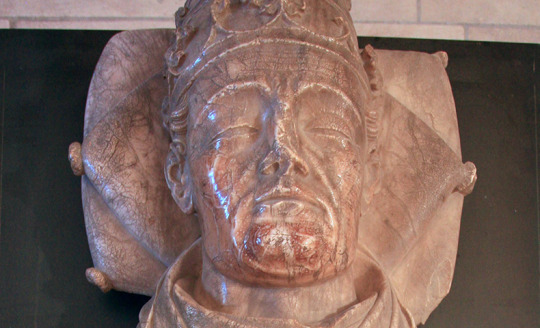
(via AnaStpaul – Breathing Catholic)
30 notes
·
View notes
Photo

























Le Mont Saint-Michel
Mont Saint-Michel (pronounced [lə mɔ̃ sɛ̃ mi.ʃɛl]; Norman: Mont Saint Miché, English: Saint Michael's Mount) is an island commune in Normandy, France. It is located about one kilometre (0.6 miles) off the country's northwestern coast, at the mouth of the Couesnon River near Avranches and is 100 hectares (247 acres) in size. As of 2009, the island has a population of 44.
The island has held strategic fortifications since ancient times and since the 8th century AD has been the seat of the monastery from which it draws its name. The structural composition of the town exemplifies the feudalsociety that constructed it: on top, God, the abbey and monastery; below, the great halls; then stores and housing; and at the bottom, outside the walls, houses for fishermen and farmers.
The commune's position — on an island just 600 metres from land — made it accessible at low tide to the many pilgrims to its abbey, but defensible as an incoming tide stranded, drove off, or drowned would-be assailants. The Mont remained unconquered during the Hundred Years' War; a small garrison fended off a full attack by the English in 1433. The reverse benefits of its natural defence were not lost on Louis XI, who turned the Mont into a prison. Thereafter the abbey began to be used more regularly as a jail during the Ancien Régime.
One of France's most recognizable landmarks, visited by more than 3 million people each year, Mont Saint-Michel and its bay are on the UNESCO list of World Heritage Sites. Over 60 buildings within the commune are protected in France as monuments historiques.
Now a rocky tidal island, the Mont occupied dry land in prehistoric times. As sea levels rose, erosion reshaped the coastal landscape, and several outcrops of granite emerged in the bay, having resisted the wear and tear of the ocean better than the surrounding rocks. These included Lillemer, the Mont-Dol, Tombelaine (the island just to the north), and Mont Tombe, later called Mont Saint-Michel.
Mont Saint-Michel consists of leucogranite, which solidified from an underground intrusion of molten magma about 525 million years ago, during the Cambrian period, as one of the younger parts of the Mancellian granitic batholith. (Early studies of Mont Saint-Michel by French geologists sometimes describe the leucogranite of the Mont as "granulite", but this granitic meaning of granulite is now obsolete).
The Mont has a circumference of about 960 m (3,150 ft) and its highest point is 92 m (302 ft) above sea level.
The tides can vary greatly, at roughly 14 metres (46 ft) between high and low water marks. Popularly nicknamed "St. Michael in peril of the sea" by medieval pilgrims making their way across the flats, the mount can still pose dangers for visitors who avoid the causeway and attempt the hazardous walk across the sands from the neighbouring coast.
Polderisation and occasional flooding have created salt marsh meadows that were found to be ideally suited to grazing sheep. The well-flavoured meat that results from the diet of the sheep in the pré salé (salt meadow) makes agneau de pré-salé (salt meadow lamb), a local specialty that may be found on the menus of restaurants that depend on income from the many visitors to the mount.
The connection between Mont Saint-Michel and the mainland has changed over the centuries. Previously connected by a tidal causeway (a path uncovered only at low tide), this was converted into a raised (permanently dry) causeway in 1879, preventing the tide from scouring the silt around the mount. The coastal flats have also been polderised to create pastureland, decreasing the distance between the shore and the island, and the Couesnon River has been canalised, reducing the dispersion of the flow of water. These factors all encouraged silting-up of the bay.
On 16 June 2006, the French prime minister and regional authorities announced a €164 million project (Projet Mont-Saint-Michel) to build a hydraulic dam using the waters of the river Couesnon and the tides to help remove the accumulated silt, and to make Mont Saint-Michel an island again.
The construction of the dam began in 2009. The project also includes the removal of the causeway and its visitor car park. Since 28 April 2012, the new car park on the mainland has been located 2.5 kilometres (1.6 miles) from the island. Visitors can walk or use shuttles to cross the causeway.
On 22 July 2014, the new bridge by architect Dietmar Feichtinger was opened to the public. The light bridge allows the waters to flow freely around the island and improves the efficiency of the now operational dam. The project, which cost €209 million, was officially opened by President François Hollande.
On rare occasions, tidal circumstances produce an extremely high "supertide". The new bridge was completely submerged on 21 March 2015 by the highest sea level for at least 18 days, as crowds gathered to snap photos.
The original site was founded by an Irish hermit, who gathered a following from the local community. Mont Saint-Michel was used in the sixth and seventh centuries as an Armorican stronghold of Gallo-Roman culture and power until it was ransacked by the Franks, thus ending the trans-channel culture that had stood since the departure of the Romans in 460. From roughly the fifth to the eighth century, Mont Saint-Michel belonged to the territory of Neustria and, in the early ninth century, was an important place in the marches of Neustria.
Before the construction of the first monastic establishment in the 8th century, the island was called Mont Tombe (Latin: tumba). According to legend, the archangel Michael appeared in 708 to Aubert of Avranches, the bishop of Avranches, and instructed him to build a church on the rocky islet.
Unable to defend his kingdom against the assaults of the Vikings, the king of the Franks agreed to grant the Cotentin peninsula and the Avranchin, including Mont Saint-Michel traditionally linked to the city of Avranches, to the Bretons in the Treaty of Compiègne (867). This marked the beginning of the brief period of Breton possession of the Mont. In fact, these lands and Mont Saint-Michel were never really included in the duchy of Brittany and remained independent bishoprics from the newly created Breton archbishopric of Dol. When Rollo confirmed Franco as archbishop of Rouen, these traditional dependences of the Rouen archbishopric were retained in it.
The mount gained strategic significance again in 933 when William I Longsword annexed the Cotentin Peninsula from the weakened Duchy of Brittany. This made the mount definitively part of Normandy, and is depicted in the Bayeux Tapestry, which commemorates the 1066 Norman conquest of England. Harold Godwinson is pictured on the tapestry rescuing two Norman knights from the quicksand in the tidal flats during a battle with Conan II, Duke of Brittany. Norman ducal patronage financed the spectacular Norman architecture of the abbey in subsequent centuries.
In 1067, the monastery of Mont Saint-Michel gave its support to William the Conqueror in his claim to the throne of England. This he rewarded with properties and grounds on the English side of the Channel, including a small island off the southwestern coast of Cornwall which was modelled after the Mount and became a Norman priory named St Michael's Mount of Penzance.
As of June 2013, only the second cannon, the one closer to the wall, is on display inside the entrance to the Mont's outer wall.
During the Hundred Years' War, the Kingdom of England made repeated assaults on the island but were unable to seize it due to the abbey's improved fortifications. The English initially besieged the Mont in 1423–24, and then again in 1433–34 with English forces under the command of Thomas de Scales, 7th Baron Scales. Two wrought-iron bombards that Scales abandoned when he gave up his siege are still on site. They are known as les Michelettes. Mont Saint-Michel's resolute resistance inspired the French, especially Joan of Arc.
When Louis XI of France founded the Order of Saint Michael in 1469, he intended that the abbey church of Mont Saint-Michel become the chapel for the Order, but because of its great distance from Paris, his intention could never be realised.
The wealth and influence of the abbey extended to many daughter foundations, including St. Michael's Mount in Cornwall. However, its popularity and prestige as a centre of pilgrimage waned with the Reformation, and by the time of the French Revolution there were scarcely any monks in residence. The abbey was closed and converted into a prison, initially to hold clerical opponents of the republican regime. High-profile political prisoners followed, but by 1836, influential figures—including Victor Hugo—had launched a campaign to restore what was seen as a national architectural treasure. The prison was finally closed in 1863, and the mount was declared a historic monument in 1874. Mont Saint-Michel and its bay were added to the UNESCO list of World Heritage Sites in 1979, and it was listed with criteria such as cultural, historical, and architectural significance, as well as human-created and natural beauty.
In the 11th century, William of Volpiano, the Italian architect who had built Fécamp Abbey in Normandy, was chosen by Richard II, Duke of Normandy, to be the building contractor. He designed the Romanesque church of the abbey, daringly placing the transept crossing at the top of the mount. Many underground crypts and chapels had to be built to compensate for this weight; these formed the basis for the supportive upward structure that can be seen today. Today Mont Saint-Michel is seen as a building of Romanesque architecture.
Robert de Thorigny, a great supporter of Henry II of England (who was also Duke of Normandy), reinforced the structure of the buildings and built the main façade of the church in the 12th century. In 1204, Guy of Thouars, regent for the Duchess of Brittany, as vassal of the King of France, undertook a siege of the Mount. After having set fire to the village and having massacred the population, he was obliged to beat a retreat under the powerful walls of the abbey. Unfortunately, the fire which he himself lit extended to the buildings, and the roofs fell prey to the flames. Horrified by the cruelty and the exactions of his Breton ally, Philip Augustus offered Abbot Jordan a grant for the construction of a new Gothic architectural set which included the addition of the refectory and cloister.
Charles VI is credited with adding major fortifications to the abbey-mount, building towers, successive courtyards, and strengthening the ramparts.
youtube
youtube
youtube
youtube
youtube
https://www.youtube.com/watch?v=umRp_f0Jyak.
2 notes
·
View notes
Photo









AN INCOMPLETE HISTORY OF MEDIEVAL ART LII
ROMANESQUE LOCATIONS
The often conflicting needs of monastic isolation, security, pilgrimages, land ownership, and the liturgy dictated the siting and orientation of ecclesiastical architecture in the 11th and 12th centuries.
#romanesque architecture#pilgrimage roads#rule of st benedict#the cult of the saints#relics#medieval art#sanctuary#christian spirituality
26 notes
·
View notes
Photo

New Post has been published on https://vacationsoup.com/planning-a-visit-to-mont-saint-michel/
Planning A Visit To Mont-Saint-Michel
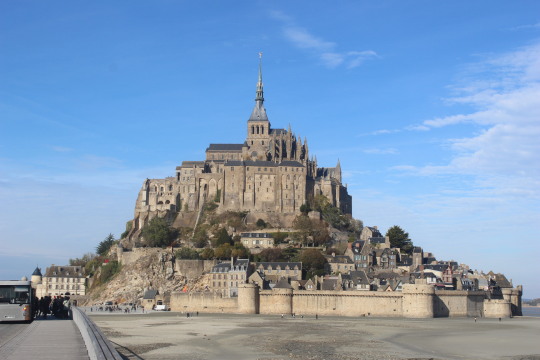
An Introduction to Mont-Saint-Michel
A visit to Mont-Saint-Michel should definitely be on your Normandy bucket list. It's a rocky island commune topped with a 13th century Gothic abbey. Discover 13 centuries of history and restoration at this UNESCO World Heritage site. The iconic abbey is perched on top of an island and it literally takes your breath away the first time you see it. It’s magical and an absolute must-see for visitors to Normandy.
If you want an overview of what to expect at Mont-Saint-Michel then take a look at Rick Steves' video. This was published in 2009 and shows vehicles parked near to the Mount. This isn't possible now but check out the 'Practical Information' section about parking. You'll get to see the main street with the shops and restaurants as well as the abbey.
If that's whetted your appetite, then read on to discover more about the island and its history, the abbey, the dam, shops and restaurants, things to do in the area, practical information and how to make the most of your visit to Mont-Saint-Michel.
The History of Mont-Saint-Michel
Mont-Saint-Michel's long history began in 708 when Bishop Aubert of Avranches erected a sanctuary on the island of Mont Tombe in honour of the Archangel Michel. Benedictine monks settled there in 966 and were responsible for the growth of the new monastery and its focal point for pilgrims.
The diverse architectural styles reflect construction methods dating from the 10th century when it was first built through to the 19th century restoration. The Abbey church is built on the summit of the Mount at an altitude of 80 metres and sits on an 80 metre long platform consisting of four crypts built into the spur of the rock. The abbey church is known as La Merveille; a thirteenth century addition regarded as its crowning glory. The Mount is positioned on the border between Normandy and Brittany and was both a place of passage and a fortress for the Duchy of Normandy.
The abbey buildings have been transformed throughout the centuries. The conflicts of the Hundred Years War between France and England in the 14th century led to powerful fortifications being built. These additions included a wall flanked with defensive towers and enabled Mont-Saint-Michel to resist attacks by English troops. It remains the only place in Normandy not to have been conquered by the English and is a symbol of national identity. In 1421, during a terrifying siege, the Romanesque chancel of the church collapsed, and was not completely rebuilt until 100 years later, in a flamboyant Gothic style.
During the 17th and 18th centuries the Mount lost its importance in both military and religious terms. Following the French Revolution the monks of Mont-Saint-Michel were driven away and the abbey became a prison until it finally closed in 1863. While the prison saved the Abbey from destruction this former religious monument was severely dilapidated. In 1874, the Abbey was classified as a historical monument and the long process of restoration began. A causeway, constructed in 1878, made access to the Mount easier. This was followed by a tramway line for transporting visitors whose numbers continued to grow.
In 1969, a small community of Benedictine monks was established at the Abbey, who were replaced in 2001 by the Monastic Fraternities of Jerusalem. The conservation work led to it being listed as a UNESCO World Heritage Site in 1979.
In 2014 a building project started 10 years previously saw a dam and a new elevated road bridge opened. The previous causeway had permanently linked Mont-Saint-Michel to the mainland. However, the tidal surges in the bay had led to the area becoming silted up. In July 2014 the new bridge returned Mont-Saint-Michel to an island which now becomes cut off from the mainland at very high tides. 2016 saw the statue of Saint Michel being re-guilded. Today the Archangel shines brightly on top of the world. This project involved shrouding the abbey spire with scaffolding and removing the statue by helicopter before it was replaced. A year long project during 2017 focussed on the restoration of the cloister. The Abbey therefore undergoes continuous building work led by the Chief Architect of Historical Monuments.
Have a look at this video which shows the setting of this delightful island commune.
The Abbey
A visit to Mont-Saint-Michel isn't complete without visiting the abbey. Only certain parts of it are open to the public and you follow the signs which take you on a journey across three different levels and through time.
At the entrance to the abbey, is a stone staircase which will take you to a security point located in the original Guard Room. There may well be a queue of people here belonging to groups and tours. Groups take the left hand side of the staircase and individuals use the right hand side. Once through security (bags will be scanned and you walk through an airport-style scanner to check you have no metal objects on you), head for the ticket office on the right. Purchase your ticket, audio guide if required and pick up a leaflet. Retrace your steps to go back to the Guard Room and head over to another stone staircase once your ticket has been checked. You're now on the lower floor of the building and are going to go up to the upper floor.
The first part of the tour is outside. Climb up the wide stone stairs of what is known as Le Grand Degré which sits between the abbey buildings and the church. Look up and you'll see suspended passageways built between the 14th and 16th centuries that linked the two sides. At the top of the stairs are some restrooms (currently the only ones in the abbey) and a small open area giving a great view toward the dam. Go through a small room where there are some models showing the development of the Mount. Walk out into the open and onto the west terrace. If the weather is good, so much the better as you'll have great views here across the bay. Tombelaine and Mon-Dol are the two smaller islands you can see. Brittany is to your left and the Normandy coastline to your right.
Before you head into the abbey church, take a look at the Neogothic spire of the church tower. It was built in 1897 and has a gilded statue of Saint Michel as it's crowning glory.
The gilded statue on the church spire at Mont-Saint-Michel
Now head into the church and explore before crossing a small room (gift shop) that leads to the cloister. Traditionally cloisters are the centre of an abbey but the Mont-Saint-Michel has buildings on only two sides. One side has three arched windows which give a wonderful view across the bay. The cloister leads directly into the refectory - a vast room with pillars down either side an a wooden vaulted ceiling.
You now leave the upper floor and walk down the stone steps to the middle floor. The first room you visit on this floor is La Salle des Hôtes (Guests' Hall) which is directly underneath the refectory. Another huge room which was designed for receiving royalty and nobility. From here, you walk through La Chapelle Saint Madelaine. Leaving here there's a brief visit into the open air before you walk into a crypt (Crypte des gros piliers). This crypt was built in the mid 15th century and supports the Gothic chancel of the abbey church which is directly above. The large pillars and small windows make the crypt rather dark so head over to the right hand side of the crypt to the exit if you don't want to linger too long here.
A short walk along a passageway leads to another crypt (Saint Martin) that's is directly underneath the south arm of the abbey church transept. The visit then takes you to the big wheel (La Grande Roue) that occupies the former ossuary where human bones exhumed from churchyards were preserved. The wheel was installed around 1820 and was used to hoist provisions up to the prisoners during the time it was a prison. It replaced pulleys that were used for hoisting building materials up the building during the middle ages. You can see where the pulleys were on the outside of the building slightly towards the left hand side of the building.
La Grande Roue
Another small chapel (Saint Étienne) leads on from here and was the chapel of the dead. Leaving here, you climb another staircase - the north south stairs - which is directly below the west terrace in front of the abbey church. At the top of the stairs turn right into a covered walkway which the monks used as an ambulatory. Stairs lead down into La Salle des Chevaliers (the Knights' Hall). This vast room was built to support the cloister which sits directly above it and was where the monks worked and studied. This room, together with the cloister, are my favourite parts of the building.
Salle des Chevaliers at Mont-Saint-Michel
To leave the middle floor, take the spiral stone staircase down to the lower floor which will take you briefly into the other end of the ticket hall. This room is known at the almonry and was where monks received the poor as well as pilgrims. You then walk through into the gift shop and out into the open air. You're now at the back of the Mount and can get a view of the small chapel at the base of the rock. Walk through the small garden and back out through a turnstile onto some steps slightly lower down from the entrance to the abbey. If you turn right as you come through the turnstile you'll be heading towards the Abbey entrance. Heading left will take you towards the ramparts and you can now explore the village.
Mont-Saint-Michel ramparts
For an in-depth behind the scenes view, watch this amazing video below. Given special access to secret passageways and hidden areas of the abbey, it's a fascinating insight into those parts of the abbey that aren't open to the public. It's in French but sub-titled in English. You may need to click on the settings icon (the cog) to activate the subtitles.
The Island
If you want to explore the small village, it's completely free to wander around. Watching the spectacle of walkers crossing the bay, glorious sunsets or sunrises as well as the high tides are free. Early morning and evenings tend to be quieter.
Crossing the bay on foot should only be attempted with an experienced guide due to quicksand and a rapidly advancing tide. The list of guides for crossing the bay is here
https://www.ot-montsaintmichel.com/en/traversees-baie-msm.htm
You can also hire a guide to help you discover the surrounding area, the village and the abbey. The list is here.
https://www.ot-montsaintmichel.com/en/visites-guidees-individuels.htm
There are two entrances to the village. The main one is straight ahead of you as you walk along the bridge road.
Near the main entrance
This leads to an entrance where you'll find the tourist office and restrooms. Walk through another gate with a drawbridge and you arrive in the narrow cobbled street which leads to the foot of the abbey steps. This street (La Grande Rue) is pretty commercial with souvenir shops, bars, restaurants and galleries. However, it's the only place to buy refreshments on the island and consuming food and drink in the abbey isn't permitted.
There is a small flat grassy area below the abbey where you can pause and take a picnic. At the top of the main street is the parish church of St-Pierre, cemetery and four museums. Also look up as you navigate the cobbles at the houses above the shops. These houses were built in the 15th and 16th centuries. Details about the parish church and museums is here https://www.ot-montsaintmichel.com/en/visite-mont-saint-michel.htm
For a list of restaurants inside the walls
https://www.ot-montsaintmichel.com/en/restaurants/inside-msm.htm
Details of shops in the village
https://www.ot-montsaintmichel.com/en/commerces.htm
If you want a pretty expensive omelette, then perhaps La Mère Poulard restaurant experience is for you. Established in 1888, the house speciality is a fluffy omelette cooked in a copper pan over the fire. Read the story here https://lamerepoulard.com/en/home2/
The second entrance is to the left of the main entrance and is a much quieter route away from the shops.
The second entrance to Mont-Saint-Michel
Practical Information
Getting There
Address:
Abbaye du Mont-Saint-Michel
50170 Le Mont-Saint-Michel
Ph. : 33 / (0)2 33 89 80 00
GPS COORDINATES
Latitude : 48.6360
Longitude : -1.5114
BY CAR
From Saint-Malo and the West: Take either the D 155 and D 797 or then N 176 to Pontorson, then D 976. From Caen and the East: Take the A84 and N 175 in the direction of Rennes. At Pontaubault take the D 43, D 75 and D 275 to Le Mont-Saint-Michel. Follow the signs for the parking and 'navettes' (shuttle buses). There are two entrances to the car park.
You'll be directed to a parking area and will take a ticket as you go through the barrier. Take this ticket with you as you'll need to visit a payment machine just prior to returning to your car. For information about parking costs, click here http://www.bienvenueaumontsaintmichel.com/en/preparing-your-visit/prices
You now have three options to get to the island - on foot (30 - 45 minutes), a free shuttle bus called Le Passeur (12 minutes) or a horse drawn carriage which is a paid service. More information is here http://www.bienvenueaumontsaintmichel.com/en
BY TRAIN/BUS
A special bus route runs from Pontorson train station to the island with journeys scheduled to connect with the train timetable. For more information see here. http://www.bienvenueaumontsaintmichel.com/en/preparing-your-visit/arriving-by-train
The Tourist Information Centre
The centre is near the car park and is open 10am - 6pm every day except 1 January and 25 December. There's an exhibition about the island, restrooms, baby changing facilities, car park ticket machines and kennels. Animals (other than guide dogs or assistance animals) are not permitted on the shuttle bus. You can take your pet to the island by walking there although they are not allowed in the abbey.
Download their brochure here
http://www.bienvenueaumontsaintmichel.com/file/medias/cppmsm-anglais.pdf
Opening hours for the abbey
Information is here http://www.abbaye-mont-saint-michel.fr/en/Prepare-for-your-visit/PRATICAL-INFORMATION
The abbey is closed: 1 January, 1 May and 25 December. For the last few years, visitors have been able to enjoy extended evening opening hours which have been very popular.
Prices for entry to the abbey
Information is here http://www.abbaye-mont-saint-michel.fr/en/Prepare-for-your-visit/PRATICAL-INFORMATION#price
Entry to the abbey is free of charge on the first Sunday of the month, between November and March. Audio guides are an additional 3€.
There are scheduled guided tours throughout the year in French and English. There are usually two a day - one in the morning and one in the afternoon. You don't need to book and there's no additional charge on top of your admission fee. They last around an hour and a quarter. Ask at the ticket desk for information. There are additional tours and talks in French http://www.abbaye-mont-saint-michel.fr/Actualites You could also organise your own tour of the abbey and or the village with an English speaking guide (see the info in section about The Island), pick up the English version of the short leaflet in the ticket hall or buy an audioguide.
The Surrounding Area
Take a look at the 2018 brochure of the surrounding area including helicopter trips, train rides around the bay, American and German cemeteries, artisan producers, health and well-being experiences, biscuit shops and nature trails.
https://issuu.com/bitpontorson/docs/mon_complice/1?ff=true&e=32899822/58977612
The Dam
The damn is built at the mouth of the Couesnon rives and regulates the ebb and flow of the water. It came into operation in 2009 and offers a great view of Mont-Saint-Michel. If you catch the free shuttle bus, you can get off at Place du Barrage and explore the dam. It's the second stop. The bus starts at the tourist Information Centre/car park. The first stop is for a small number of shops, restaurants and cafés. The second is for the damn and the third stop takes you within 350m from the base of the Mount.
More information about the dam is here
http://www.projetmontsaintmichel.com/en/organise_your_visit/dam_tours.html
How can you make the most of your time there?
During the summer it is busy but given it’s an UNESCO World Heritage site, it’s not surprising. The information above will give you some of the practical information on tide times, parking, the shuttle buses etc. I’d recommended going early or late in the day to avoid the crowds. Between 12 and 2pm is also a good time as many people will be lunching. Saturday can also be a good time as this is often the start and end day for holidays in peak season. The summer evening openings are also a little quieter.
The main entrance is to the left of the red and yellow Normandy flag.
If the tide is low enough, head for the building on the far left instead. This is a quieter route and gives you a great view of those fascinating turrets you can see. It’s often busy around the steps leading up to the abbey but there are two queues and one is for groups. You should take the queue on the right hand side which is for individuals. Once you’ve got your tickets, take a free leaflet and decide if you want to purchase an audio guide. Then, you can wander round to your hearts content admiring the amazing architecture and views across the bay. Take your time as it’s not easy to double back as in places you go down narrow spiral stone staircases.
To help you plan your time at Mont-Saint-Michel, the following websites may be useful
http://www.abbaye-mont-saint-michel.fr
English version http://www.abbaye-mont-saint-michel.fr/en/
http://www.ot-montsaintmichel.com/en/accueil.htm and also http://www.bienvenueaumontsaintmichel.com/en
For tide times click here https://www.ot-montsaintmichel.com/FCKeditor/UserFiles/Brochures-OTMSMN/HORAIRE-DES-MAREES-2018-OT.pdf
This leaflet is also very useful and includes a map of the island
https://www.ot-montsaintmichel.com/FCKeditor/UserFiles/Nouveaux-plans-du-Mont/Mont-Saint-Michel_map_ANGLAIS.pdf
Damn information and leaflet
http://www.projetmontsaintmichel.com/en/organise_your_visit/dam_tours.html
Useful Tips
There are a lot of steps on the island and in the abbey
Taking a pushchair isn't recommended due to the steps and cobbled streets
Check the tide times and opening times of the abbey
Take your time in the abbey as doubling back isn't easy
Restrooms are located at the Tourist Information Office, inside the main entrance to the island, at the top of La Grande Rue and at the top of the first staircase in the abbey
Refreshments can be purchased before you get to the island is the shops near the car park or in the bars and restaurants on the island.
Food and drink shouldn't be consumed in the abbey
Dogs aren't allowed on the shuttle bus or in the abbey. They are permitted to go on the island and possibly in bars and restaurants depending on their policy.
Some ticket machines for the car park only take cash and others only take credit card
Take your car parking ticket with you and pay for it before you return to your vehicle. Machines are near the Tourist Information Centre and the main walkways to the car parks.
Enjoy your visit to Mont-Saint-Michel!
We spent 3 weeks creating the best online guide to Normandy on the web. It includes everything from a bucket list, must see attractions to the best places to eat and drink.
It covers Mont St Michel, Monet’s garden, the D Day beaches, wine tours and much more. .
It’s packed with our personal recommendations, maps and videos.
CLICK HERE FOR OUR THINGS TO DO IN NORMANDY GUIDE
Travel Tip created by Chris in association with Vacation Soup
#France#gavray#HolidayInGavray#Mont-Saint-Michel#montsaintmichel#normandy#VacationInGavray#VacationSoup#whattodo
0 notes



